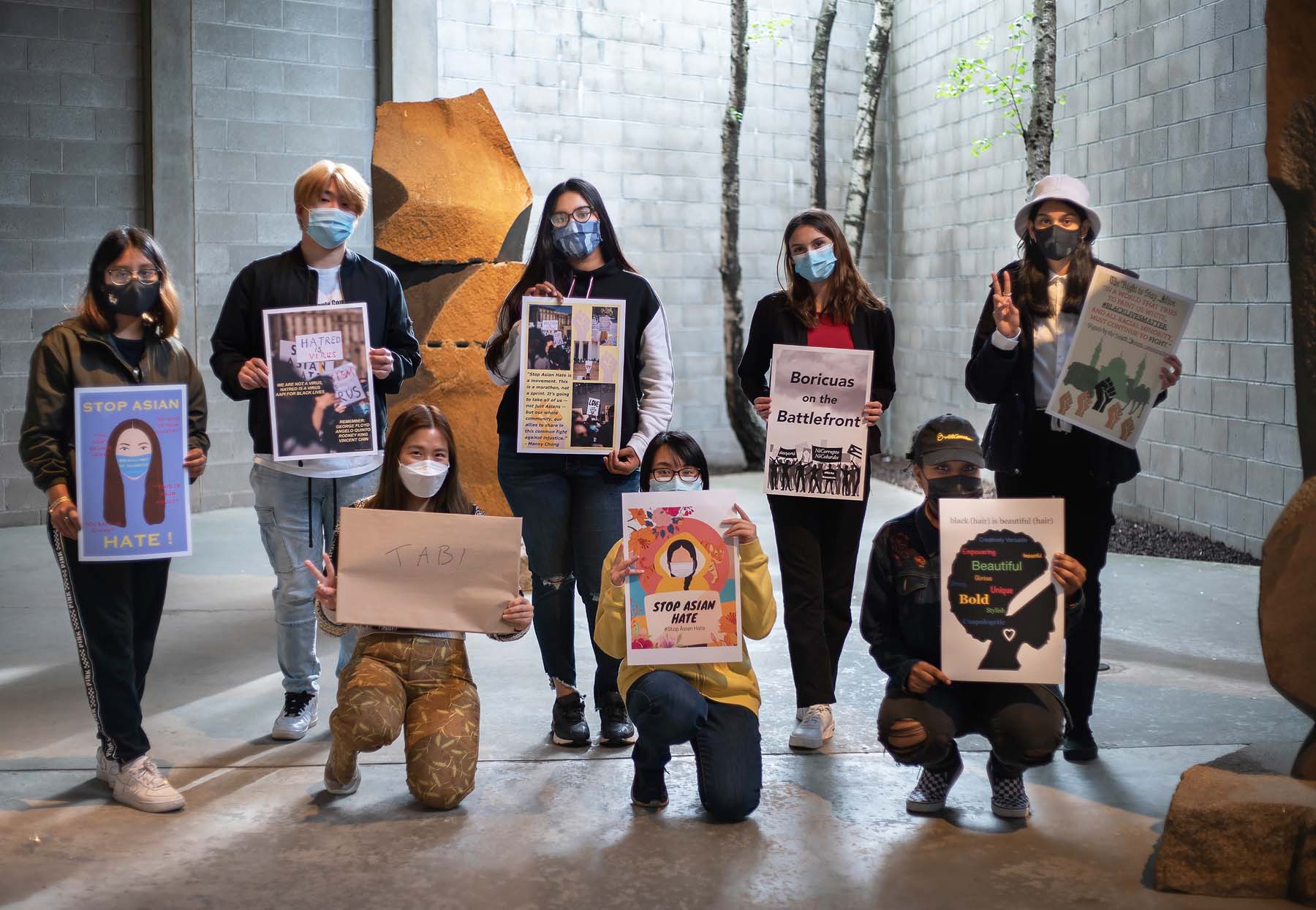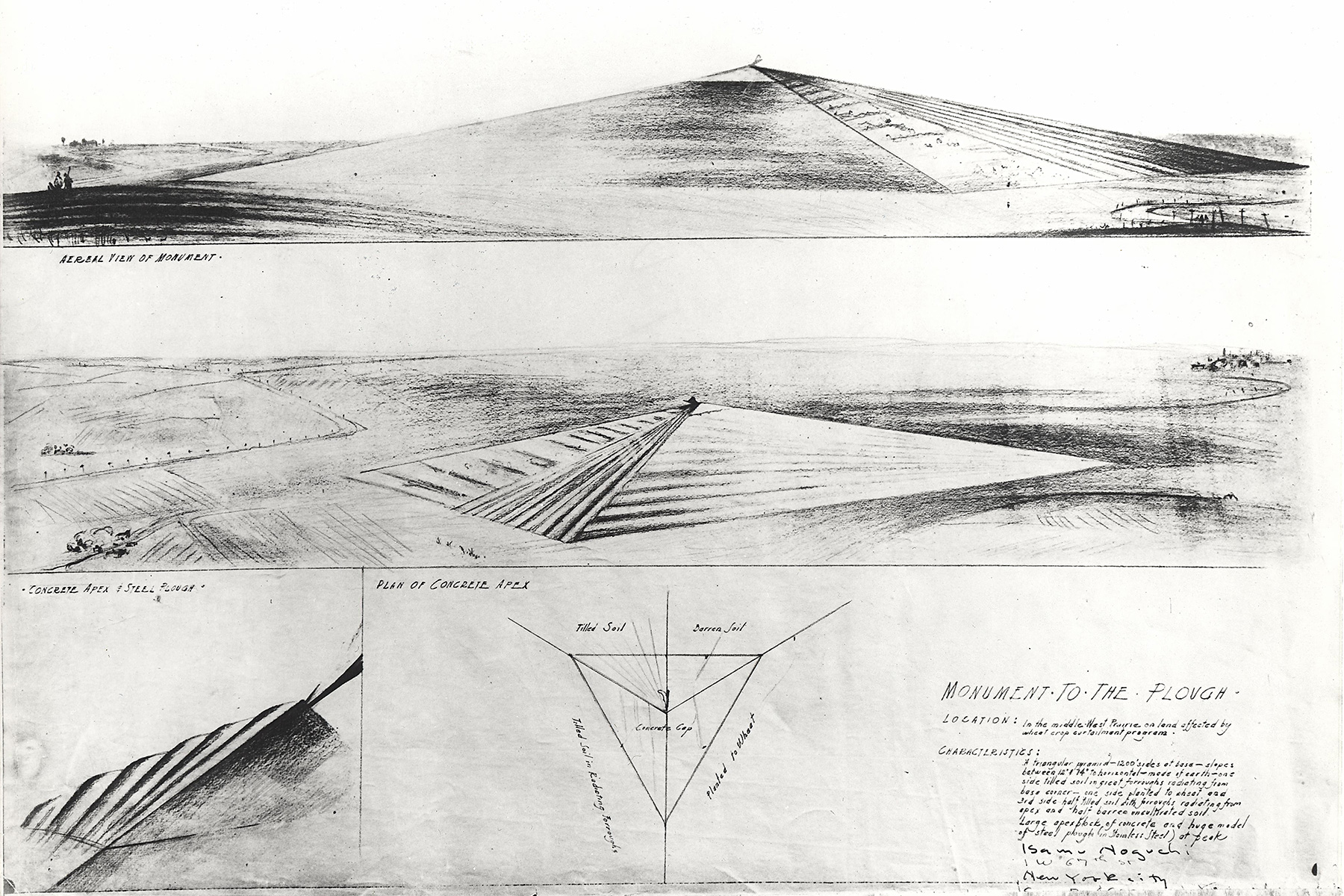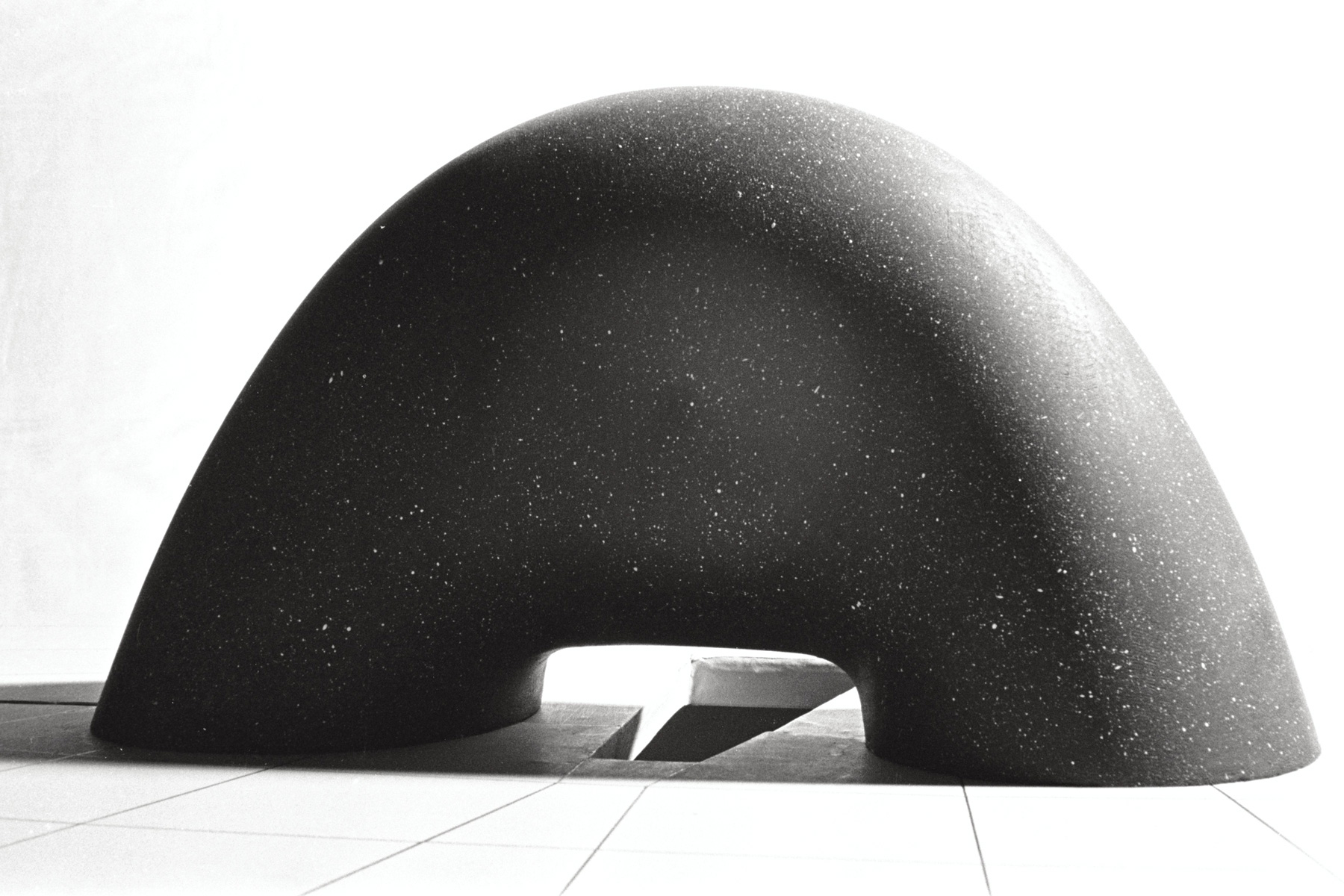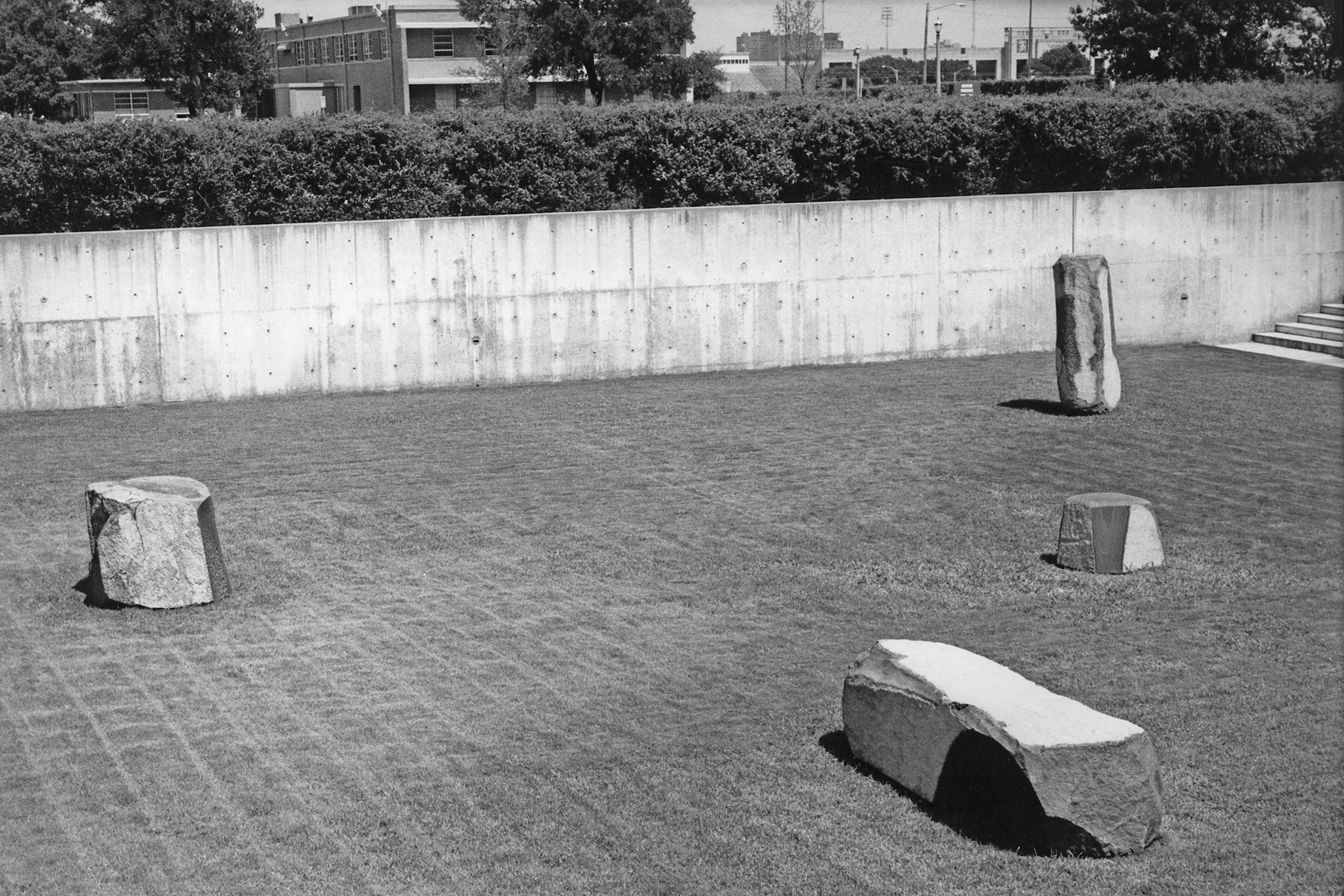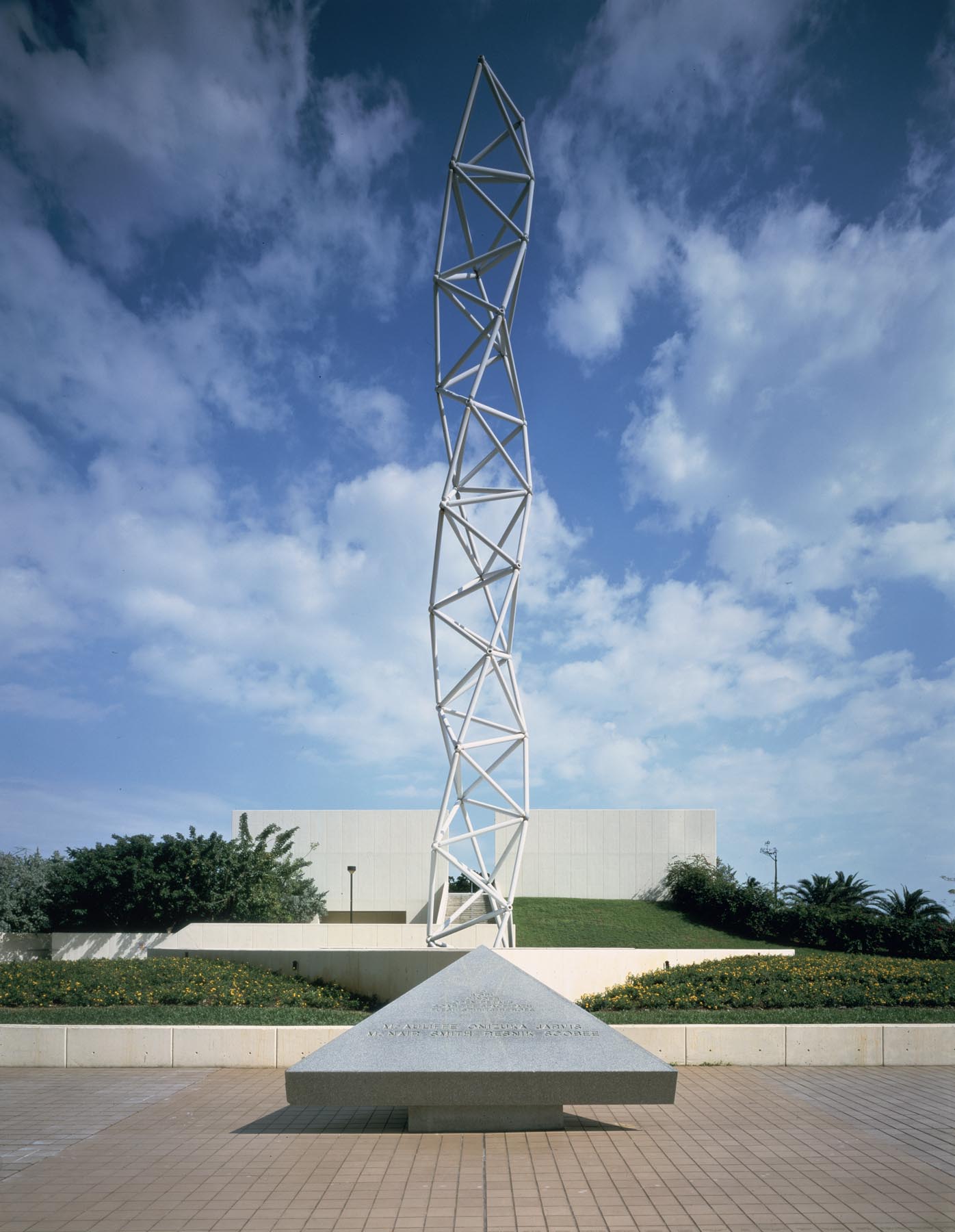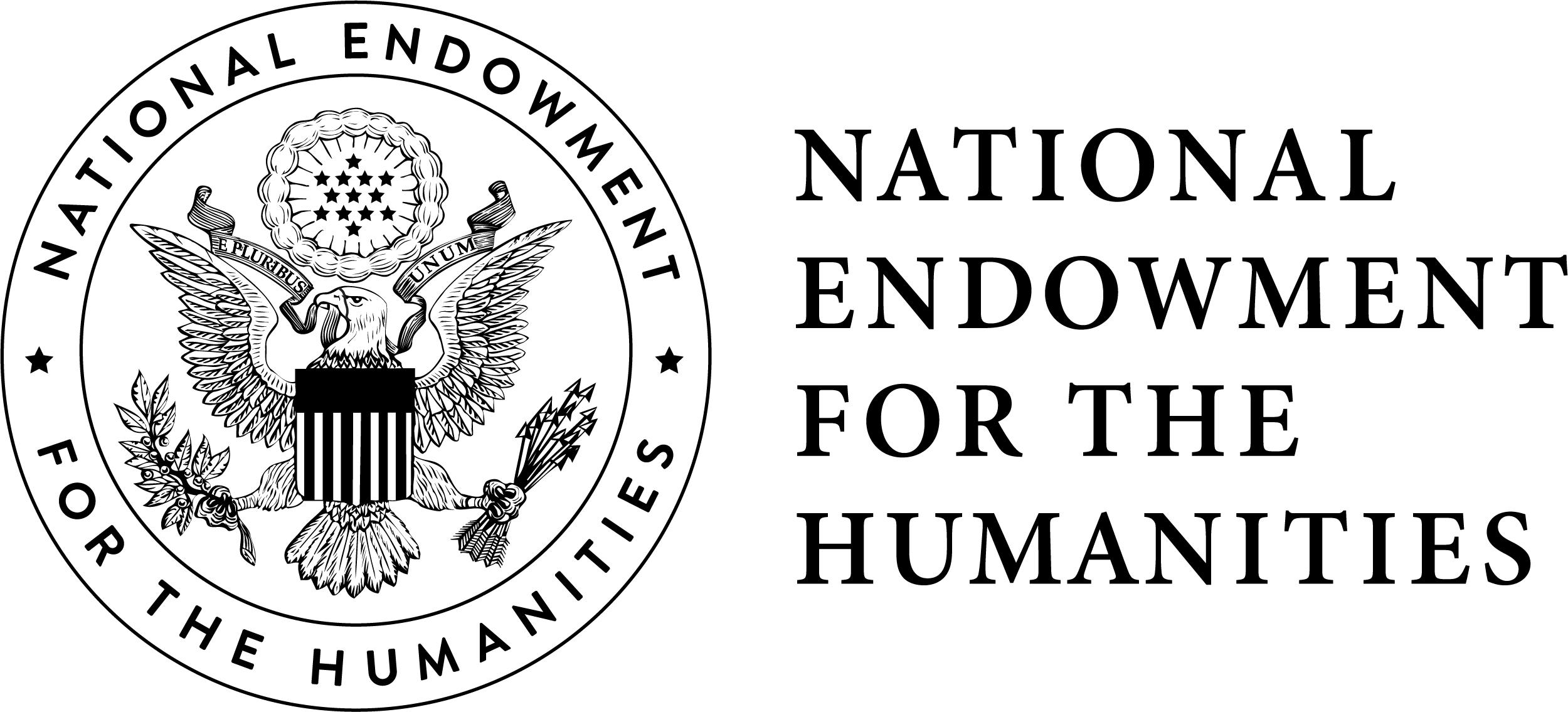By Spencer Bailey
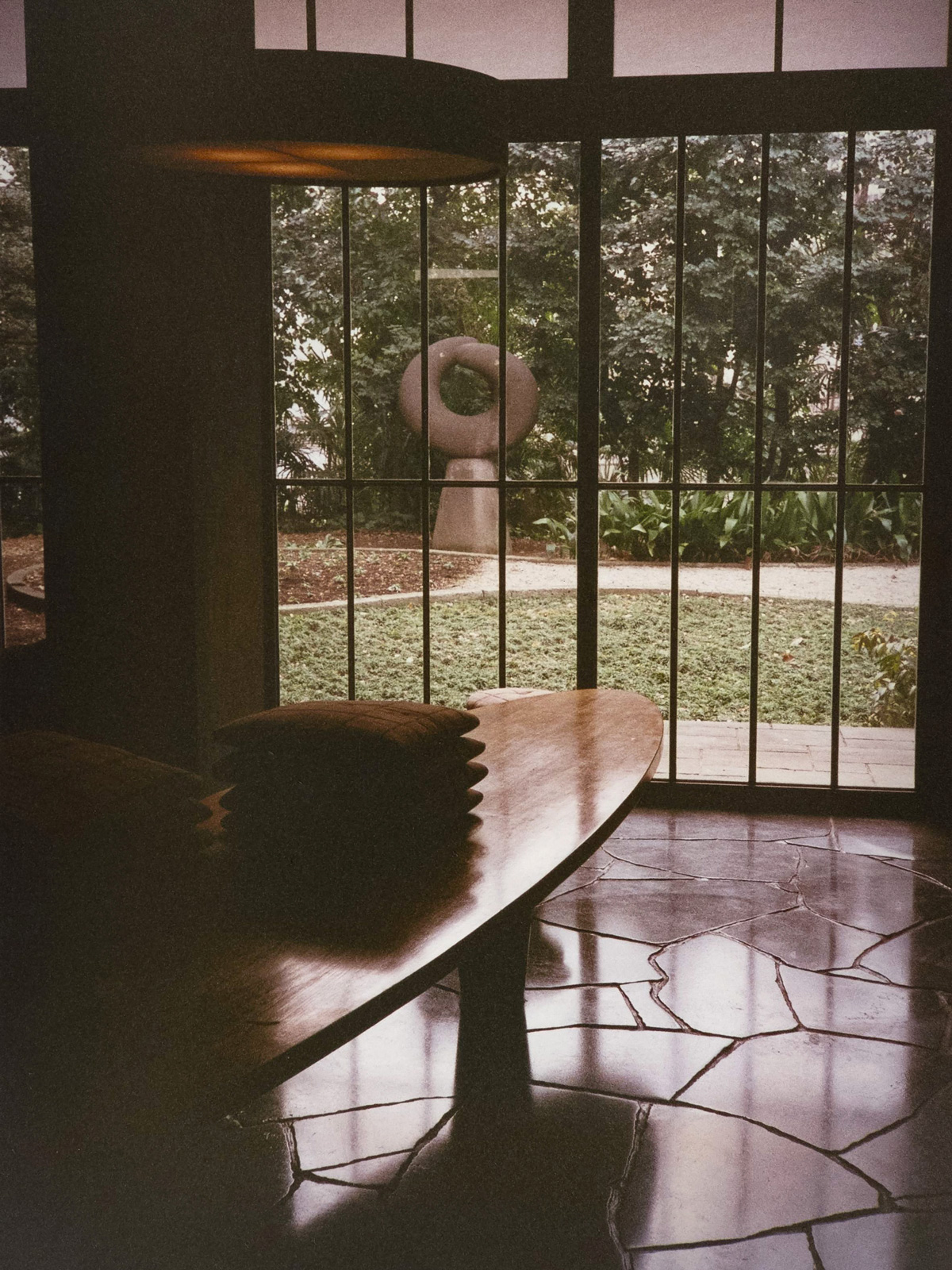
Throughout his life, Isamu Noguchi thought deeply about memory and memorials. In fact, he devised fifteen memorial designs, five of which were completed prior to his death on December 30, 1988.
Considering himself a citizen of “Spaceship Earth,” Noguchi’s universal worldview was exemplified in his memorial making, perhaps evidenced nowhere more clearly than through his concept for the immense Sculpture to Be Seen From Mars (1947).1 His Japanese American identity, and the evolving conflicts he felt therein, also came out through his multifarious memorial projects: while he designed a memorial to Benjamin Franklin—and effectively, American ingenuity—in 1933 (it would be completed more than fifty years later, in 1985), as well as another that same year to the American plow, an innovation attributed to Franklin and Thomas Jefferson, he would also put forward, just eighteen years later, a memorial dedicated to the atomic bombing victims of Hiroshima, the deadly result of America’s technological, industrial, and military might. That he was torn between identities, cultures, and societies was his quiet strength as a designer of memorials. Such projects were no doubt a productive way for Noguchi to work through his shifting allegiances and polar perspectives.
What made Noguchi special, or even spectacular, as a memorial maker was his aim of capturing something spiritual—a sort of transcendence of space and time through physical abstraction. His memorials were made to be experienced. Between 1950 and 1953, when devising a project dedicated to Gandhi, for example, he sought to create “a living memorial in which many people may participate.”2 Memorials were, for him, democratic acts of un-forgetting.
Noguchi understood how to create ambitious works that were evocative exactly because of their ambiguity. Their power and strength lies in their pairing of abstraction with a certain level of specificity—enough to make clear what’s being memorialized while still allowing for a multitude of meanings, interpretations, and responses. “One does not silently bury the dead building a monument,” Noguchi once wrote.3 He sought to make profound works that deal with “today’s problems” and capture various ideas at once—“aspirations, problems, sufferings.”4
While Noguchi was without question singular in his approach to memorials, his creations followed pathbreaking examples by Auguste Rodin, who was commissioned in 1884 to create a monument to the burghers of Calais in France, and Constantin Brancusi, whom Noguchi worked under in Paris for five months in 1927, and who created the towering Endless Column memorial in Târgu Jiu, Romania, completed in 1938 and dedicated to the soldiers who died fighting off the Germans from that town during World War I. Noguchi would evoke Endless Column in several projects, built and unbuilt, including the Memorial to Buddha (1957) and the Challenger Memorial (1985–87). When conceiving his Challenger project, Noguchi also looked to Vladimir Tatlin’s plans for the never-built Monument to the Third International (1919–20) as a reference (the Tatlin monument had long interested him: on a brief trip to Moscow in 1930, Noguchi had tried to find the structure, which he thought had been built, to no avail).5
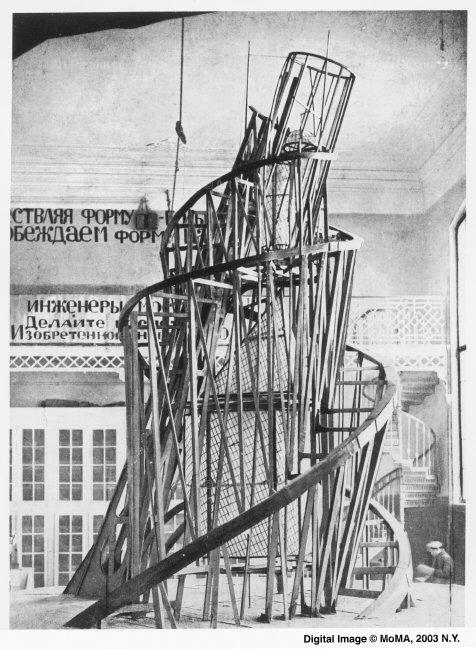
© The Museum of Modern Art / Licensed by SCALA / Art Resource, NY
- Vladimir Tatlin, Model of the Monument to the Third International, 1920.
© The Museum of Modern Art / Licensed by SCALA / Art Resource, NY
It’s worth mentioning here, too, that earlier in his life, after graduating from high school in Indiana in 1922, Noguchi apprenticed with the sculptor Gutzon Borglum, famous as the creator of Mount Rushmore. During this period under Borglum, in a live public performance and a true showing of his skill, Noguchi produced an impressively exacting study model of Borglum’s sculpture Seated Lincoln (1911), and in the following two decades, he became a prominent maker of portrait busts—his primary means of supporting himself early on.6
Perhaps tainted by the experience of working under Borglum (who had discouraged him from becoming an artist), or maybe also in spite of it, Noguchi later went on to become a pioneering force in the creation of largely nonfigurative works of memorialization. In many ways, Noguchi’s memorials were anti-monuments, beyond nationhood, universal reminders of humanity’s interconnectedness.
In the late twentieth century, as Noguchi saw the completion of three of his memorials—and as Maya Lin realized her Vietnam Veterans Memorial (1982), a sea change in the memorialization conversation—a large global memorial culture began to emerge, moving more and more toward minimalism and abstraction.7 Noguchi himself was an admirer of Lin’s design, and clearly felt connected to it, writing in a 1983 letter that it was “in keeping with my thoughts.”8

- Maya Lin, Vietnam Veterans Memorial, 1982.
The memorials by Rodin, Brancusi, and Noguchi no doubt helped lay the groundwork for this late-twentieth-century evolution. The diversity of the shape and style of memorial designs, as well as the subject matter, would expand greatly in the decades to come, as seen in standout projects such as Stanley Saitowitz’s New England Holocaust Memorial (1995) in Boston, Rachel Whiteread’s Judenplatz Holocaust Memorial (2000) in Vienna, Peter Eisenman’s Memorial to the Murdered Jews of Europe (2005) in Berlin, Michael Arad and Peter Walker’s Reflecting Absence (2011) at the World Trade Center, and MASS Design Group’s National Memorial for Peace and Justice (2018) in Montgomery, Alabama.
Noguchi’s Carl Mackley Memorial, named for a hosiery factory worker killed during a 1930 labor strike, was the artist’s first memorial design, conceived around the same time as his Bolt of Lightning … Memorial to Ben Franklin and similar to it in its figurative-meets-abstract language. Depicting two arms at work, a hand with scissors, lines of yarn, and a spool on rotation (“the tools of their industry,” as Noguchi put it),9 the artist’s design had an elegance and grace, with strong, curvaceous forms reminiscent of those in later works such as News, his 1938 stainless-steel bas-relief sculpture for the Associated Press Building at Rockefeller Center.
Proposed to be located at the Carl Mackley Houses, a five-building development designed in the International Style by Oscar Stonorov and Alfred Kastner for the Philadelphia Hosiery Workers Union (and financed by a loan from the Public Works Administration), the memorial concept came as the nation slid toward the depths of the Great Depression, with the future prospects for organized labor appearing bleak. But just several years later, in 1938, the Fair Labor Standards Act was enacted, eliminating child labor, establishing a minimum wage, and creating mandates for overtime compensation. Though the memorial was never built, the housing complex was completed in 1935. That same year, a plaster model of the memorial was presented alongside one for Bolt of Lightning in an exhibition at the Marie Harriman Gallery in New York.10 “Sculpture can be a vital force in our everyday life if projected into communal usefulness,” reads a line at the footer of the exhibition brochure.11
The Carl Mackley Memorial may be one of the earliest examples of Noguchi’s political engagement. Less than a decade later, during World War II and in solidarity with his fellow Japanese Americans, Noguchi would self-intern at the Poston War Relocation Center in the Arizona desert.12
“With his great interest in ancient cultures and his archaeological imagination,” writes the art historian and cultural critic Dore Ashton in her 1992 book Noguchi East and West, “[Noguchi] had persistently sought out the kind of prodigious collaborative works in which men had moved mountains—sometimes in actuality, sometimes figuratively. This impulse, with its herculean implications, had immense appeal to Noguchi.”13 Perhaps no Noguchi project, other than his 400-acre Moerenuma Park (2005) in Sapporo, Japan, or Sculpture to Be Seen From Mars (1947), exemplifies this ambition better than Monument to the Plow, an earthwork proposed to be built, in Noguchi’s words, “preferably at the geographical center of the United States.”14
Noguchi’s design consisted of a triangular pyramid of soil, approximately one mile wide at each base, with one side plowed, the second planted, and the third left fallow. The memorial was to be topped with an abstract stainless-steel sculpture resembling a plow. Dedicated to Thomas Jefferson and Benjamin Franklin, who together are credited with inventing the American plow, the memorial was Noguchi’s paean to the opening of the western plains, “a monument to American beginning.”15 “My model indicated my wish to belong to America,” Noguchi writes in his autobiography, “to its vast horizons of earth.”16
With this project, Noguchi was no doubt embracing his Americanness (his mother, Léonie Gilmour, was a U.S. citizen; his father, Yonejiro Noguchi, was Japanese), even leaning into the nineteenth-century Manifest Destiny stance that American settlers were bound for expansion across North America.17 In some ways, the project could be seen as a reflection of Noguchi’s yearning to belong to America, even at a time—following World War I and in the throes of the Great Depression—when the country was economically teetering. The tilling of the land suggested renewal and hope for the future. “From there things started to open up for me,” Noguchi once said of conceiving the monument. “And it was to the mythology, if you will, of a new country, the new earth, and how it would be tilled with this plow.”18 Noguchi would wrestle with his mixed-race identity, and the American side of himself in particular, throughout his life. His memorials, in many ways, would serve as helpful material for working through the messiness of it.
As with the Carl Mackley Memorial, this project was not to be. When Noguchi presented the scheme to the Public Works of Art Project (PWAP), a new federal relief program for artists as part of President Franklin D. Roosevelt’s New Deal, his proposal was flatly denied. The Washington office of the PWAP, in the words of one official, “turned their thumbs down… so hard that they almost broke their thumbnails.”19 This did not deter Noguchi from pursuing his similarly ambitious Play Mountain (1933), though. When he presented that plan, a playground-landscape concept of sloping surfaces—steps, a curved ramp, a pool—covering a New York City block, to the city’s famously cantankerous parks commissioner, Robert Moses, it, too, was met with a gruff reception.
Ashton notes in her book that, four decades later, Noguchi described to her “an enormous project of earth-moving that involved four miles of industrial waste in Illinois.”20 That would remain unrealized, as well. The grass pyramid of Moerenuma Park would come to be the closest thing built by Noguchi at that scale, though posthumously.
In 1942, Noguchi voluntarily entered into the Poston War Relocation Center, the largest of the Japanese American incarceration camps in the United States during World War II. There he hoped to establish an arts-and-crafts program, redesign the camp (one plan even included a botanical garden and a miniature golf course), and connect with his fellow Japanese Americans. But in reality, the self-exile turned out to be an exceptionally bleak period for the artist. While it provided him a direct way to show solidarity, it led to him becoming isolated, viewed suspiciously by the authorities and, still an outsider of sorts, considered a spy by some of the internees. He would spend a total of six months at Poston, only getting out by begging for release and applying to leave “for private employment.” Noguchi would never forget the experience.21
A year later, he created Monument to Heroes, a commemorative column “for aviators who became heroes” during World War II, featuring “the bones of the unknown—the residue of bravery, blown by winds.”22 Writing in the exhibition catalogue for the traveling 1978–79 exhibition Noguchi’s Imaginary Landscapes, Walker Art Center director Martin Friedman describes Monument to Heroes as “one of the most specific and melancholic examples” of Noguchi’s time at Poston.23 The totemic model, made of painted cardboard, wood, bone, and string, and likely a tribute to the crews who flew mission after mission over occupied Europe during the war, humbly shows Noguchi’s vision for what he imagined as “a large cylinder on a mountain top with the wind blowing through it and things dangling there like skeletons. It was a dirge for futile heroes who killed themselves—for what?”24
“A mordant comment on heroic memorial columns of the past” is how the arts journalist Grace Glueck described the memorial in the New York Times.25 For Noguchi, the use of bones carried deep meaning and suggested an intrinsic connection with the past. In fact, bones were a frequent motif for the artist, and he collected some, which he said he sourced from a storage attic at New York’s Museum of Natural History. “To go back is to go forward, in a way,” Noguchi once told the interviewer Paul Cummings, speaking of The Monument to Heroes in particular, “because, if you go back to bedrock, then you have something to stand upon.”26
A ten-mile-long earthwork depicting an abstract human face, Noguchi’s Sculpture to Be Seen From Mars was, as the artist himself once put it, “a requiem for all of us who live with the atomic bomb”27 and alternatively “a flight of the imagination.”28 Prompted by the World War II atomic bombings of Hiroshima and Nagasaki, which horrified Noguchi—“he often spoke of his fear of atomic annihilation,” Hayden Herrera writes in Listening to Stone—he began thinking about end-of-mankind scenarios.29 “It was in 1945, wasn’t it, when we dropped the atomic bomb?” Noguchi once reflected. “All of us were concerned about our place on earth, and that it might be rather precarious.”30
For Noguchi, the monumental work was intended to be “an eternal reminder to the rest of the solar system that the planet earth, seemingly bent on self-destruction, once had its civilizations,” writes Friedman in the Imaginary Landscapes catalogue, hailing it as the artist’s “most impressive memorial to the futility of war.”31 The work, as Friedman points out, was also Noguchi’s way of showing his respect and reverence for ancient and indigenous monumental forms, such as the pre-Columbian geometric earthworks in the Andes. “‘Earth sculpture’ is nothing new,” Noguchi said. “It’s just a new name for an old thing.”32
The earthwork also connected to Noguchi’s ongoing interest in outer space and the cosmos. When the art critic Lucy Lippard asked Noguchi to use a photograph of the project in her 1983 book Overlay, paralleling contemporary art with prehistoric sites and symbols, Noguchi replied, “I recently saw a reproduction of a face which was found in the landscape of Mars taken by the Viking Satellite. I think it would be very appropriate to show this version along with mine. I have written to the Mars Research Laboratory asking for this image and will send it to you if you are interested.”33 The connection of rocks across the universe was not lost on the artist. “Ultimately,” Noguchi told Calvin Tomkins in The New Yorker in 1980, “I like to think that when you get to the furthest point of technology, when you get to outer space, what do you find to bring back? Rocks!”34
An incredibly moving, visionary concept that, as Friedman notes, in many ways preceded the land art and conceptual art movements that would emerge and flourish in the second half of the twentieth century, Noguchi’s memorial to mankind was intended for “some desert, some unwanted area.”35 It was, as the artist put it, “a sculpture just to be seen from the air so that, when you come to a landing, you will see the sculpture there.”36 That Noguchi was concurrently working on the Jefferson National Expansion Memorial suggests he was balancing both a belief in America’s future technological prospects and an acknowledgment of the bleak potential for mankind to destroy the planet and itself. Sculpture to Be Seen From Mars is today only memorialized in a single photograph of a model Noguchi had formed out of sand.
In 1947, Noguchi and the architect Edward Durell Stone collaborated on an entry to the competition for the Jefferson National Expansion Memorial Park on the St. Louis waterfront. Calling for a central monument emphasizing westward expansion and to include a museum, the competition brief had few other requirements.37 The pair’s concept, primarily known through a few extant photographs, put an emphasis on “growing things, water and sculpturally molded terrain,” and placed architectural and infrastructural elements mostly underground.38 It was in essence—and especially for its time—an anti-monument monument.


Inspired by American Indian mounds (particularly the Great Serpent Mound in Marietta, Ohio, which Noguchi had recently visited), as well as his own concept for Contoured Playground (1941), Noguchi proposed a surprising yet subtle geometric earthwork. “In order to enhance the area as a park,” Noguchi wrote, “the architecture was almost totally buried, with only mound shapes showing.”39 A quietly spiritual tribute to America’s indigenous past, Noguchi and Stone’s scheme ultimately lost out to Eero Saarinen’s towering Gateway Arch—a sweeping symbol of the modern era.
Throughout his life, Noguchi had a long engagement with India, and had formed many friendships in New York with people from India who had “welcomed me unchanged.” He was also awarded a Bollingen Foundation fellowship to travel to the country in 1949, which furthered his interest. Despite this, Noguchi felt that he was viewed as an outsider in the country. “Entering Asia,” he wrote of the Bollingen trip, “I felt myself becoming an intruder. If I wish to think so, mixed-blood disqualifies additionally beyond the question of race.”
During his travels through India that year, Noguchi went to places such as Bombay (“not for me,” he wrote of the city); Madras, where he spent time with the dancer Uday Shankar; Pondicherry, where he visited the ashram of Sri Aurobindo and stayed in the the Antonin Raymond–designed Golconda dormitory (considered by many to be the first modernist building in India); and Tiruvannamalai, where he met the Hindu sage Ramana Maharshi. He also visited ancient monuments, including the Taj Mahal and the Jantar Mantar in Jaipur and Delhi, two of five astronomical observatories built by Maharajah Sawaii Jai Singh II in the eighteenth century, which he was particularly excited by. For Noguchi, India wasn’t just a connection to his Asian roots, complicated as that was; it was also a place of deep spiritual connection. “The search for India seems to go on and on,” he wrote in his Bollingen papers.40
A year before the Bollingen trip, following the assasination of Mahatma Gandhi on January 30, 1948, Noguchi found himself moved to create a memorial to the celebrated nonviolent-resistance leader, citing his own “attachment to the Orient and to what Gandhi’s work stood for.”41 Producing a model he described as “the Outstretched Hand of Humanity,” he sent the proposal to Jawaharlal Nehru, then the prime minister of India and uncle of Noguchi’s one-time love, Nayantara Pandit, or Tara. Around this time, Tara had sent Noguchi a letter, as well, writing of Gandhi’s passing, “There is no way of describing to you the void that his death has created, how unbearably empty life is,” adding, “He was our friend and confidante, the father of the nation in so many ways, the person above all whom we could talk to for advice and guidance no matter what our troubles were.”42 Tara’s grandfather had been close with Gandhi, and Tara herself had even called Gandhi “Bapu,” meaning “father.”43
When Noguchi shared the design with Tara, she appreciated it, taking note of its “starkness & austerity.” Unfortunately, the timing for such a memorial was not in Noguchi’s favor, as India was in political turmoil following Gandhi’s killing. She wrote that her uncle Nehru, who could have helped make the memorial happen, was “anti-monument of any kind.”44
Nonetheless, when Noguchi later went to India to make a portrait of the prime minister, he persisted. It was there that Nehru asked Noguchi to try to improve the park design for Gandhi’s burial-place at Raj-Gat. His proposal, designed “in the form of a grass covered truncated pyramid open in the middle,” was to be constructed in stages. The memorial was to include a nine-foot-tall “hedge of massive square monoliths” with carvings of “the story of India’s people, especially the poor, led to freedom through Gandhi’s teaching,” as well as two bisecting pathways with “an alignment of sculptures.”45 Though his specific design would remain unrealized, in his autobiography Noguchi later writes, “I was startled, on a recent trip, to see that this idea had been carried out.”46
Noguchi’s first memorial proposal for Japan following the bombings of Hiroshima and Nagasaki, Bell Tower for Hiroshima, was to be a tall, open structure designed as “a standing thicket of rods from which huge brass bells would be suspended,” writes Martin Friedman in the Imaginary Landscapes catalogue. “Noguchi intended that the bells, activated by the wind, would provide a muted, ghostly reminder of what had transpired.”47 Conceived without a sponsor—Noguchi hoped to find one—the memorial was presented as a model, made of ceramic and wood, in the artist’s exhibition at Mitsukoshi Department Store in Tokyo, his first presentation in Japan. He was never able to find the funding.
The Bell Tower proposal and the Mitsukoshi exhibition, made using whatever basic materials he had at hand, were conceived “under rushed conditions, in a land barely finding its way out of the debris of war,” Noguchi wrote in the November 1950 issue of Arts & Architecture.48 It was during this time that Noguchi found himself precariously perched between his Japanese and American selves, with the Japanese, “a people who have lost so much,” looking to him for some sort of answers, for a way forward. Writes Noguchi: “I suggested that to be modern did not mean to copy us [Americans] but to be themselves, looking to their own roots for strength and inspiration.”49
Mainly consisting of sculptural ceramic works Noguchi made with ceramicists in Japan’s Seto region, the Mitsukoshi exhibition also included a plaster model of the sculpture Mu (1950), which he had labored over at the Industrial Arts Research Institute, on the invitation of industrial designer Isamu Kenmochi.50 Mu would soon be realized in sandstone and installed as part of Shin Banraisha (1951–52), a memorial space dedicated to Noguchi’s father at Keio University in Tokyo. One of the ceramic works in the show, Skin and Bones (1950), featured a cross-stick construction similar to the Bell Tower model and also was not entirely dissimilar in vernacular to A Monument to Heroes.
Following the exhibition, as a result of the Bell Tower proposal, Noguchi was asked to propose a project for Peace Memorial Park in Hiroshima. This would lead to the designs of two memorial bridges in the city, adjacent to the park.51



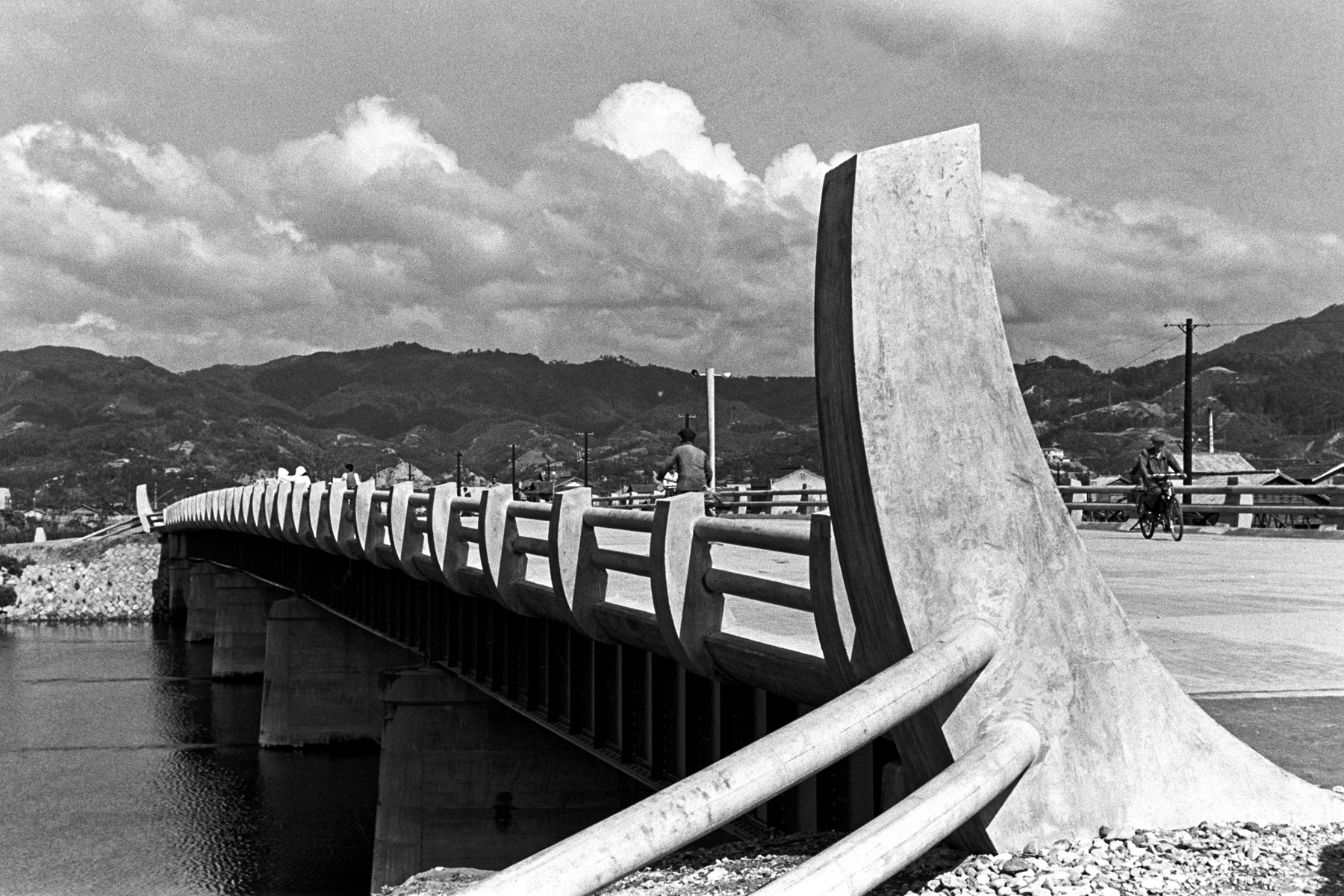
In the summer of 1951, Noguchi visited Hiroshima—still devastated from the atomic bombing five years before—and toured the city with architect Kenzo Tange, who had won the competition to design its Peace Memorial Park. What he witnessed was devastating. There was “absolutely nothing there,” he once told the art historian Dore Ashton. “And all the graves [were] upturned, and everything [was] all knocked over. And all the traces of the bomb. The buildings are burned, the shadows of people who had been sitting there reflected on the granite. Everything had been burned.”52
On the invitation of Tange and the mayor of Hiroshima, Shinzo Hamai, Noguchi was soon asked to design the railings of two bridges leading to the park. “He sought ways to expiate [his] guilt [as a Japanese-American] and contribute to the idea of peace,” Martin Friedman writes of Noguchi, and this commission provided him with an apt opportunity.53 Noguchi would call his unusual abstract creations, constructed in cast concrete and scaled to relate to both the human form and the view of mountains beyond, Tsukuru (“to build”) and Yuku (“to depart”). Originally, Noguchi titled them Ikiru (“to live”) and Shinu (“to die”), but later changed the names, perhaps to be more sensitive and subtle. “The bridge with the rising sun was named Tsukuru (to build), denoting life,” Noguchi writes in his autobiography. “The other bridge, like a boat, was Yuku (to depart). Having built, we die (through holocaust?).”54
Tsukuru “rises to form huge discs, like giant antennae,” Friedman writes, while Yuku’s “curved portals … are reminiscent of the prows of funerary boats.” He adds, a bit hyperbolically, that “the stark elongated forms of these bridges suggest the bleached bones of giant prehistoric creatures that perished in a holocaust.”55 The fashion designer Issey Miyake, a longtime friend of Noguchi’s and a Hiroshima native, once referred to the bridges as the “spiritual support of the people.”56 Serving a practical transportation function, as well as a transportive psychological one, the bridges were effectively made to be portals: welcoming gestures that allowed for the tranquility of the park to take over. Perhaps they could also be viewed as a way of Noguchi traveling from his American self to his Japanese self, and vice versa.
For Noguchi, it was the use—and the usefulness—of these bridges that would prove most meaningful. As he once put it, “For years I’ve designed gardens and playgrounds—but they remained projects. These things only come alive when people live with them. Then they give meaning and they take on meaning.”57 In 2013, the newspaper Chugoku Shimbun noted in an op-ed that the bridges still remain essential reminders—“one legacy of the beginnings of the city’s recovery.”58

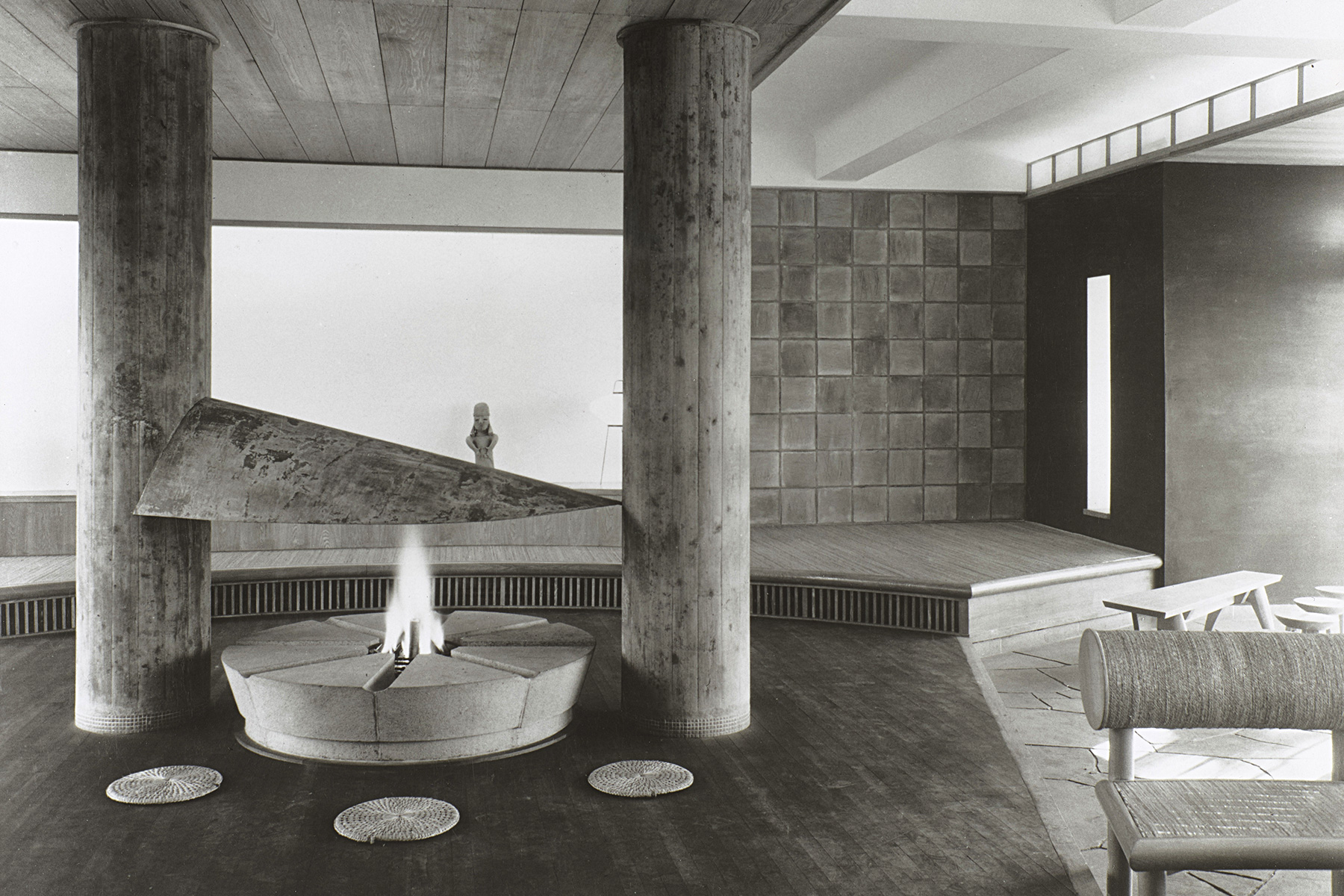


A tribute to his own father, the Japanese poet and writer Yonejiro Noguchi, who had died in 1947, Shin Banraisha resulted out of a commission Noguchi received from the architect Yoshiro Taniguchi to design the interior of a new faculty building at Tokyo’s Keio University, where Yonejiro had taught for forty years. Though Noguchi had long had a conflicted, largely distant relationship with his father—who, following his birth, abandoned him and his mother, Léonie, fleeing America for Japan—by the time the Shin Banraisha project came about, Noguchi had come to terms with his feelings. “I became preoccupied with this [project] as my own act of reconciliation to my father and to the [Japanese] people,” he writes in his autobiography.59 According to Friedman, Shin Banraisha “permitted Noguchi to reaffirm his family ties with Japan.”61
“Noguchi did not want Shinbanraisha [sic] to be a memorial exalting a hero,” Herrera writes in Listening to Stone, “but rather a place of relaxation, a place where the wounds of war might heal, and a place to contemplate ‘the ideals of beauty’ expressed in his father’s poetry.”60 For Taniguchi, who had commissioned various artists and architects as part of the Keio master plan, the collaboration with Noguchi was one among several on campus that he hoped would help form the “seeds of aesthetic consciousness in the school as it emerged from the ashes of war.”62
According to Masayo Duus, Noguchi took inspiration from the Shisen-do, a seventeenth-century Buddhist temple and poet’s retreat in Kyoto that his father had liked. Embracing modernism through his design while respecting traditional spiritual elements, Noguchi created a contemplative memorial space comprising shoji screens, custom lighting, and a fireplace—the latter emphasized by two massive cylindrical columns that he described as “earthquake-proof.”63 A contemporary seating design was subtly integrated through various platforms. “In a sense,” Duus writes, “his interior design for the Shinbanraisha [sic] was a prayer of hope for the ‘New Japan.’”64
For an adjoining garden, Noguchi created two sculptures. One of them, Mu (“nothingness”), made of sandstone, was placed on a west-facing cliff, to frame the setting sun. “Of considerable mass,” Noguchi writes in his autobiography, “[Mu] stands out well in spite of trees.” The other sculpture, Student, a fifteen-foot-tall iron-welded work, “could be seen only from below against the sky,” Noguchi writes, “and so was less successful.”65
In 2003, the university decided to demolish the building housing the memorial. Noguchi’s longtime friend and architect collaborator Shoji Sadao,66 along with the Walker Art Center’s Martin Friedman and the Asian Cultural Council president Richard Lanier, wrote a letter that same year in protest of the decision: “Coming out of a devastating war with little to inspire or encourage their development, [Shin Banraisha] was an inspiration to a whole generation of architects and artists who were only vaguely aware of the modern art movement in Europe and America.”67 The space, they declared, “is an internationally recognized masterpiece of post-war modern architecture and art in Japan.” Unfortunately, the letter was to no avail.
At roughly the same time Noguchi designed the Peace Memorial Park bridges at Hiroshima, he was invited by Tange to submit a design for a memorial commemorating the 200,000 people who died during the city’s atomic bombing. There could be “no greater honor” than this commission, Noguchi told the newspaper Asahi Shimbun at the time.68
In a letter to his friend John Entenza, editor of Arts & Architecture magazine, Noguchi wrote that the project was agreed on by Tange and Mayor Shinzo Hamai, along with himself, over tea in Hiroshima. Describing the project, which was to be unpaid, he wrote: “I agreed to contribute my share for nothing—as a matter of simple altruism, I thought, on my part in which were mixed thoughts of wanting (as a citizen of the outside world) to participate in symbolic expiation of our mutual guilt.”69
Developing his concept while working out of Tange’s Tokyo studio, Noguchi created a symbolic model for a cenotaph that he initially called the Arch of Peace. It was to include an underground repository of names, or “a cave beneath the earth (to which we all return),” as he puts it in his autobiography.70 “A true collaboration, it sought to integrate a node of central interest into the whole scheme of Peace Park,” he wrote to Entenza, continuing, “The sculptural element alone was mine.”71
Taking cues from traditional Japanese haniwa, terra-cotta figures that during the Kofun period (3rd to 6th century AD) were buried with the dead as funerary objects (and are among some of the many things Noguchi himself collected), the artist designed a twenty-foot high black granite arch “glowing at the base from a light beyond and below.”72 Noguchi’s elegantly arranged model, Tange had said, “overflowed with generosity of spirit” and evoked “the placidity of an ancient jewel.”73
In February 1952, much to Noguchi’s surprise, the cenotaph job was canceled. Mayor Hamai had sent Noguchi a letter telling him that he had been taken off the project. “Tange was as bewildered as I,” Noguchi wrote to Entneza of the experience. “All he could tell me in the beginning was that it was perhaps because I was an American.” In that same letter, he called it his “one really disagreeable experience in Japan.”74
“Unfortunately,” elaborates Noguchi in his autobiography, “both Tange and Mayor Hamai had neglected to consult with the committee in charge—specifically with Mr. Kishida Hideto, an architect and Tange’s teacher.”75 Was it because he was American? Noguchi wondered. “But, of course, I could understand that, under the circumstances, having an American make the memorial to the dead was a little too much,” Noguchi stated years later.76
In the aftermath, Tange later recalled, “the press enjoyed making a big issue out of it.”77 One article, published in the newspaper Tokyo Shimbun, attacked Noguchi as a conceited, hubristic foreigner imposing himself on Hiroshima: “In Isamu Noguchi’s blood there is mixed hay which is from overseas … Coming to occupied Japan where Nisei have clout, he spread the idea in the press that he, of all people, was the most suitable person to make the monument for the slogan ‘No More Hiroshima’—thus showing the mixed character of his temperament.”78
Considering Noguchi’s design “too difficult” for ordinary people to understand, the Peace Memorial Park committee ultimately determined that, because Tange was designing the entire park already, he should also design the cenotaph. “Tange thought the committee’s decision reflected a widening but unspoken sentiment that a memorial for the atomic bomb victims ought to be designed by a Japanese,” Duus writes in The Life of Isamu Noguchi.79 “What I find regrettable,” Noguchi would say in a 1956 magazine interview, “is that in Japan there is an especially deep-rooted problem of political—or maybe boss—favoritism.”80
Tange’s final design for the cenotaph loosely references Noguchi’s original—“another version of the haniwa roof” is how Noguchi put it—and still sits on the site today (alongside Peace Memorial Museum, Peace Memorial Hall, and Hiroshima City Auditorium, all designed by Tange).81 Over the decades, the park came to be considered by many critics and historians a modernist beacon—an exemplar of postwar globalism, merging Western modernism and traditional Japanese architecture.
In 1957, the Indian government sponsored an international competition for a commemorative monument in honor of the 2,500th anniversary of Buddhism, to be built in New Delhi. Then living in Japan, Noguchi was approached by a group of young architects who asked him to join them in a competition entry. Coincidently, in 1955, Noguchi had been queried by Manuel Jimenez of UNESCO about his interest in helping design a Buddha memorial park in Lumbini, Nepal, the birthplace of Buddha, and eventually traveled there to survey the site. “[The Nepalese government is] interested in getting in touch with an architect and garden designer who could take an interest in the project and would seem to prefer somebody who could, because of his background, be akin to Buddhism,” Jimenez wrote.82 Though that project didn’t materialize in the end, Noguchi had kept “the wonderful memory of Nepal in my mind.”83
For the New Delhi competition, Noguchi and the architects focused on the lotus flower as the main motif. “In the blossom so closely related in significance to the teachings of the Buddha,” Noguchi wrote in the team’s entry application, “we found the theme of recurrent change and rebirth. We came to realize it was not only the birth of Buddhism that we wished to celebrate, but the significance of universal birth and awakening.”84 Universalism was at the heart of Noguchi’s work, and while this project was technically religious in nature, it’s clear that it was a way for Noguchi to address the interconnectedness of all humanity, as well as a celebration of the natural world. Memorials such as this one served as vessels to speak to a higher power and transcend time and culture. In a 1985 interview with Newsweek, clearly extending out of this thinking, Noguchi described his views on religion this way: “I’m not a partisan of any religion, but there was a certain respect that religion promoted. Maybe that’s what we need now, to share an impulse, some common agreement that something is worthwhile other than having just a comfortable house. You can call it religion. You can call it art. It’s the space beyond.”85
A large white pavilion composed of three sections was to form the central “petals” of the dome; beyond them were to be nine horizontal, downward-facing petals, each containing a statue of Buddha, and three double petals inside, with six more on the exterior. Bursting out of the center was to be a seventy-foot-high cast-bronze “nine-bulbed spire, somewhat like the lotus root”—slightly reminiscent of Brancusi’s Endless Column.86 The concept was, as Martin Friedman puts it, “in some respect evocative of traditional Indian structures. Its antecedents might be such fantasy palaces as the Taj Mahal; there is even a hint of the Arabian Nights about the design.”87 Particularly notable was that, similar to Sculpture to Be Seen From Mars, this was a memorial designed with an overhead view in mind.
Without choosing a winner of the competition, the government decided to abandon the memorial project entirely. “Instead, [Jawaharlal] Nehru [the prime minister of India] decided to make the site into a garden—and a Japanese garden at that,” Noguchi would later tell Friedman.88
Seven years after the death of his friend and former collaborator the architect Louis Kahn, Noguchi began work on a Kahn memorial installation as a gift to the Kahn-designed Kimbell Art Museum in Fort Worth, Texas. The resulting Constellation (for Louis Kahn) is a series of four elegantly assembled basalt boulders, placed far apart in a contemplative arrangement on a grassy lawn adjacent to the museum. One stone is upright, another horizontal, and the other two squat, almost square—all in harmonious dialogue with Kahn’s barrel-vaulted building. The project, writes Kenneth Frampton in the catalogue to the 1996 exhibition Play Mountain: Isamu Noguchi + Louis Kahn, “was not without obstacle, for it took Noguchi a number of years to convince the museum to accept the work, and then only as a gift.”89
For Noguchi, Constellation was meant not only to honor Kahn’s life and their special collaboration, but to also show his great reverence for the architect and the Kimbell building in particular. In a letter to the Kimbell’s director, Edmund P. Pillsbury, Noguchi wrote that the stones were made “in stellar relation to your marvelous space and no other. I am the last one to intrude upon an area that I consider holy with objects that would diminish its unique emptiness.” He added, “The Kimbell Museum is also a work of art and needs to be nurtured. My sculptures were done with this in mind, and are in no way assertions of the self separate from the building.”90
Describing Constellation as a “Ryoanji-like rock garden,” a reference to the famous Zen temple in Kyoto, Hayden Herrera writes in Listening to Stone that the memorial “was anything but bleak.”91 In the Fort Worth Star-Telegram, the art critic David Hickey, who had watched Noguchi, then in his eighties, at work on the installation, noted that the artist was “poised in an almost prayer-like attitude of complete attention—watching the heavy stone, strapped to the crane hook, come floating toward him out of the sky.”92 Noguchi did indeed view the Kimbell as Kahn’s “sacred spot,” the result of “his own kind of meditation,” and so Noguchi was very much channeling that same energy.93
Noguchi’s devotion to Kahn was not surprising. From 1961 to 1964, the two had collaborated on a playground design “for children of all ages” on Riverside Drive in New York City—a commission from Audrey Hess, who intended it to serve as a memorial to her aunt, the late philanthropist Adele Rosenwald Levy. Facing much resistance and reluctance from the city’s parks department and the public—even with the necessary funding to realize it, and following a series of revisions (there were five submitted versions of the design in total)—the proposal ended in a standstill. With Constellation, Noguchi would realize, as Frampton writes, “a touching coda to a collaboration that had been both arduous and unique.”94
In many ways, the Kimbell memorial represents Noguchi’s strong belief in the power of collaboration, not entirely unlike his work with Tange on Hiroshima’s Peace Memorial Park, and reflects how much his friendship with Kahn impacted him. Not including busts he made from the 1920s to early ’40s, for the likes of Berenice Abbott, Buckminster Fuller, and Fernand Léger, Constellation would be the only explicit memorial he made to a friend.
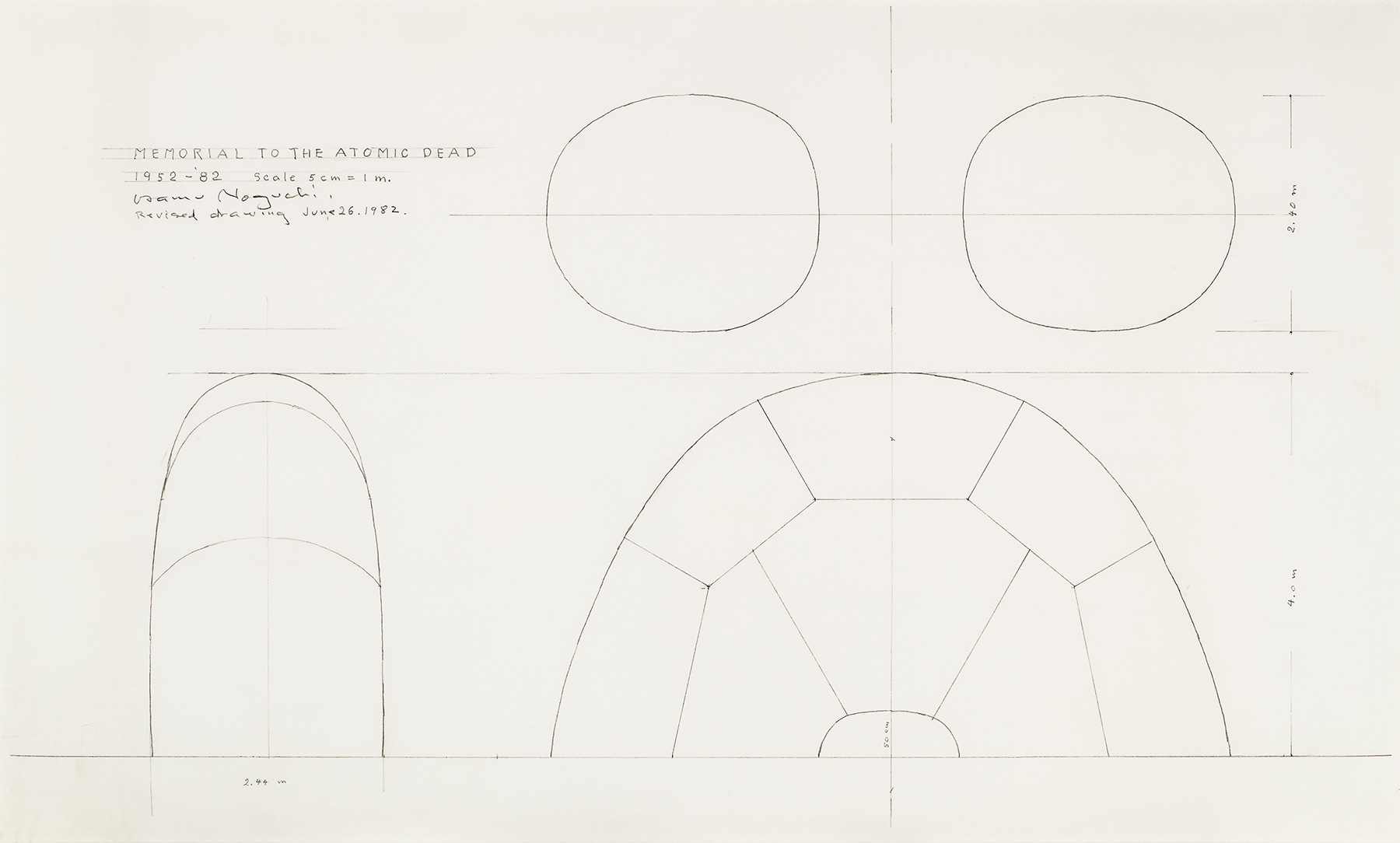

Four decades after he first conceived it, in the last years of his life, Noguchi was still searching for a way to realize his Hiroshima memorial in some form, even thinking that there may be a more appropriate spot for it in the United States—a reminder of the evil of which the country is capable. Beginning in 1981, he would search for a site for his Memorial to the Atomic Dead, but he ultimately never found a place for it.95 Even before that, in a 1973 interview, Noguchi had said of this project in particular, “My best things have never been built.”96 Upon the opening of the Isamu Noguchi Garden Museum in 1985, the artist devoted an entire permanent gallery installation to his model of the memorial.
In addition to Play Mountain, the Hiroshima memorial was perhaps one of Noguchi’s greatest unrealized obsessions. Over the decades, clearly wanting to see the project through, Noguchi proposed building it at a dizzyingly long list of locations: in Washington, DC, where he hoped to situate the memorial on the National Mall;97 in New York City, where he suggested it be installed in Riverside Park98 or Central Park,99 or in Long Island City,100 or at the Audubon Research Park in Washington Heights;101 in Los Angeles;102 in Los Alamos, New Mexico, home of the first atomic bomb test and the proposed location of a J. Robert Oppenheimer memorial;103 at Stanford University;104 in Mauna Kea, Hawaii;105 and in Paris.106 In the proposal text for Washington, DC, Noguchi’s supporter Peter Putnam declared that, recreated for this context, the design “takes on new and broade[ne]d meanings. It becomes there a symbol of our shared concern for the moral and material significance of nuclear arms.”107
According to Duus, at one point, Noguchi learned that the Peace Memorial Park cenotaph that Tange had designed in Hiroshima needed to be rebuilt and restored due to corrosion, so Noguchi called up Tange and suggested that they install his original design instead. Irritated by the suggestion, Tange wouldn’t speak to Noguchi for some time after that.
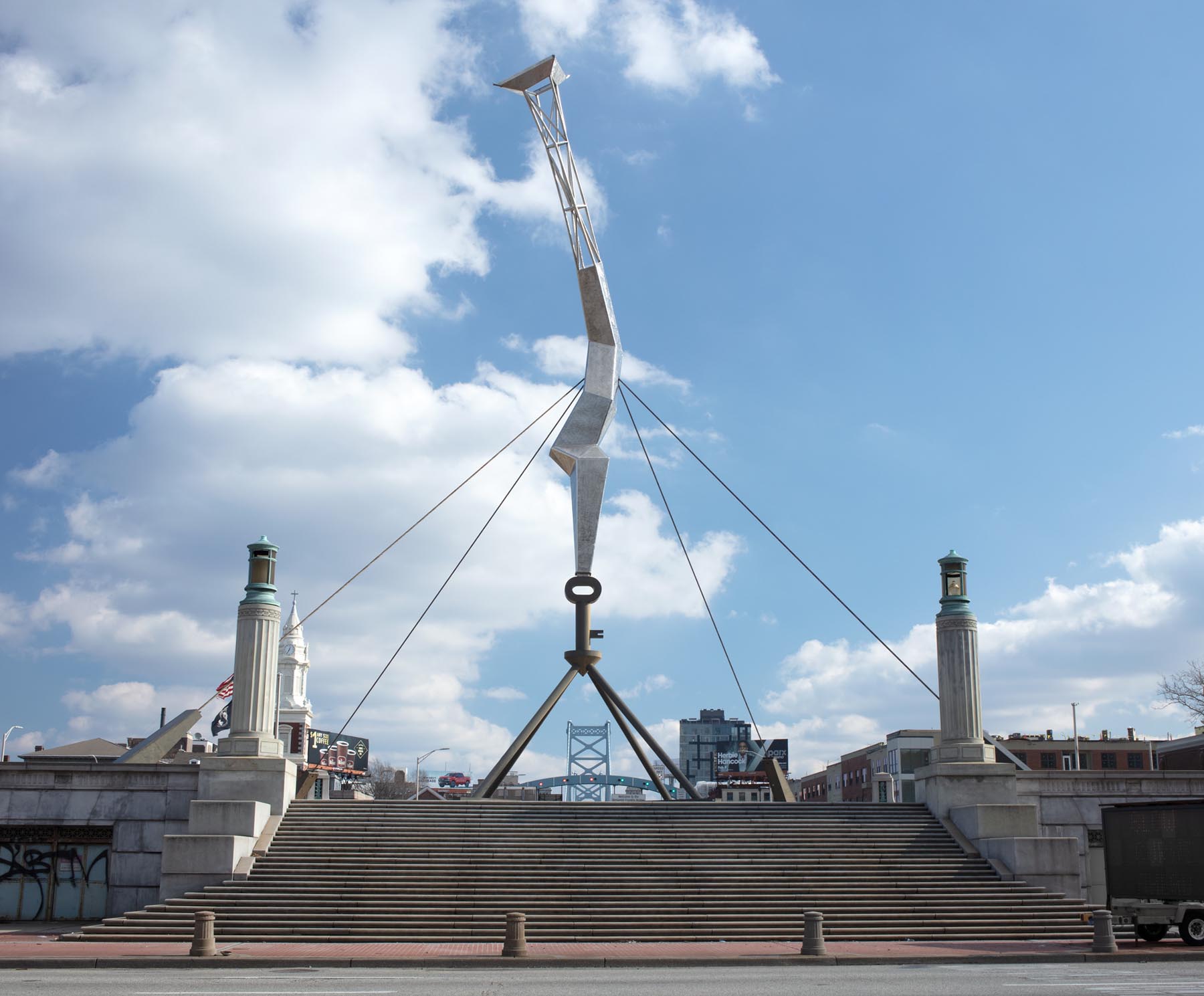
- Isamu Noguchi, Bolt of Lightning … Memorial to Ben Franklin, 1984. Photo: Kevin Noble. The Noguchi Museum Archives, 152257. ©INFGM/ARS
Noguchi’s memorial to Benjamin Franklin is a testament to patience and perseverance, as well as to Noguchi’s complicated but enduring belief in his birth country’s strength and spirit. (He was, after all, finally completing this work while still trying to find a home for his Hiroshima memorial.) Originally designed in 1933 for a competition—which Noguchi didn’t win—the sculpture, technologically advanced for its time, would finally be constructed more than fifty years later. (Noguchi was twenty-eight years old when he designed it; when it was completed, he was seventy-nine.) The idea to build it was revived in 1979, following a retrospective of Noguchi’s work at the Philadelphia Museum of Art that had included a model of the design.
More representational than most of Noguchi’s works—though certainly in line with his thinking as an artist in the 1930s, and still decidedly nonfigurative—the 102-foot tubular steel sculpture, situated at the axis of Philadelphia’s Independence Mall and the Benjamin Franklin Bridge, has a four-legged, pyramid-shaped base from which its zigzagging form rises. It is anchored to the ground by four support cables attached at its midsection. Depicting a key at the base, a bolt of lighting above that, and at the top a kite, the memorial references Franklin’s ingenuity and invention, something Noguchi felt he shared with the statesman-polymath. The gargantuan memorial, weighing sixty tons, a feat made possible with help from engineer and frequent Noguchi collaborator Paul Weidlinger, took a year and a half to fabricate.
While many initial reactions to the sculpture, as reported in the New York Times, were flattering, others were decidedly less so.108 In 1984, the Philadelphia Inquirer called it “a crumpled, bent-can of a sculpture.” Writing in Philadelphia magazine in 2010, Larry Mendte bitingly describes Noguchi’s creation as “a mistake,” adding, “It looks like a construction site abandoned long ago.”109 Weidlinger himself once described Noguchi’s sculpture as “mad” and said, “I would not have done it for anybody I didn’t like a lot.”110
Perhaps more than anything, the memorial was Noguchi’s way of expressing a forward-looking optimism for the future. “If Franklin and his kite recalled my childhood enthusiasm,” he writes in his autobiography, “it was also the sky of aspirations where the kite flies seeking its lightning.”111
Located in the southwest corner of Miami’s Bayfront Park, Challenger Memorial reaches a height of 100 feet in the form of a tetrahelix. One could easily mistake the spiraling steel, white-painted sculpture, made of thirty-one tetrahedrons, for the work of R. Buckminster Fuller, a longtime friend and creative compatriot of Noguchi’s. But it is indeed by Noguchi, who was inspired by Fuller, as well as, according to Herrera, by Vladimir Tatlin’s unbuilt design for Monument to the Third International (1920).112 A tribute to the seven astronauts who died in the 1986 Challenger space shuttle explosion, it was built to resemble a DNA molecule—Noguchi’s way of suggesting a continuity of nature. At the base is a granite triangle engraved with the names of the astronauts.
One of Noguchi’s final works, this was his last public monument to be built before his death on December 30, 1988. The memorial was officially unveiled at a ceremony in January 1989. Shoji Sadao, an architect and longtime friend of both Noguchi and Fuller, oversaw the completion of the sculpture, which was part of a larger Bayfront Park plan for which Noguchi was commissioned by the city of Miami in 1978. Despite a slew of bureaucratic obstacles over the decade to come, Noguchi and Sadao saw through about three-quarters of the park plan.
On the whole, the park was, as Noguchi put it in a 1986 interview, “a prototype or an image of the future world.” Through its design, he sought to somehow capture the fact that Challenger “had that appealing quality of the opening up of science and space and so on. There is an element of heroism and of hope.” But, he clarified, the park wasn’t about progress; rather, it was about existing on the fine line between past, present, and future. “The past is as much a part of the future as anything,” he said. “In fact, we have more knowledge of the future by looking at the past.”113 That was his greatest ability as a memorial maker: to live in the urgent, immediate present, and to also honor the past as a means to look toward the future.
At a moment in which racist monuments are being torn down, a “commemorative justice” movement is growing, and, as we deal with the COVID-19 pandemic death toll and begin to think about what a tribute to those lost to the virus might look like, Noguchi’s memorials prove incredibly instructive and prescient.114 Throughout the twentieth century, Noguchi sought to create universal reminders, not prescriptive, dictatorial monuments. Eschewing figurative statues, he understood memorialization to be an opportunity for celebrating humanity through approaches that extend across space and time. While his Sculpture to Be Seen From Mars was specifically a monument to mankind, in the end that’s what all of his memorial work was about: a direct engagement with the messy, complicated, often contradictory experience of being human.
Spencer Bailey is the author of In Memory Of: Designing Contemporary Memorials (Phaidon), cofounder of the media company The Slowdown, and cohost of the podcast Time Sensitive. He is also a member of the Board of Trustees of The Noguchi Museum. The Bolt of Lightning … Memorial to Ben Franklin and Challenger Memorial texts were excerpted from In Memory Of by permission.
Produced by Alex Miller.
Transcripts of archival materials are available by request to accessibility@noguchi.org.
1 Noguchi states, “…my particular fondness for stone derives from being on this spaceship earth…,” in Elizabeth Pond, “The Home Forum,” Christian Science Monitor, August 23, 1973. The Noguchi Museum Archives, NFP_DET_049_003. See also Dakin Hart, “Isamu Noguchi: Citizen, Spaceship Earth,” exhibition talk at M+ Pavilion, JC Cube, Tai Kwun, Hong Kong, November 17, 2018, https://stories.mplus.org.hk/en/talks/isamu-noguchi-citizen-spaceship-earth/. Noguchi’s longtime friend Buckminster Fuller popularized the phrase with his 1969 book Operating Manual For Spaceship Earth.
2 Isamu Noguchi, letter to Pandit Jawaharlal Nehru, January 7, 1950. The Noguchi Museum Archives, MS_PROJ_064_001.
3 Isamu Noguchi, letter to John Becker, September 14, 1959. The Noguchi Museum Archives, MS_PUB_023_045.
4 Isamu Noguchi, draft of “What’s the Matter with Sculpture” [1936]. The Noguchi Museum Archives, MS_WRI_004_002.
5 Hayden Herrera, Listening to Stone: The Art and Life of Isamu Noguchi (New York: Farrar, Straus & Giroux, 2016), 112.
6 Thirty of Noguchi’s portrait busts were displayed in “Isamu Noguchi Portrait Sculpture,” an exhibition at the National Portrait Gallery, April 15–August 20, 1989. See Nancy Grove, Isamu Noguchi: Portrait Sculpture, exh. cat. (Washington, DC: Smithsonian Institution Press for the National Portrait Gallery, 1989).
7 For a summary of the controversy around the memorial, see Erin Blakemore, “This 21-Year-Old College Student Designed the Vietnam Veterans Memorial,” History, February 22, 2019, https://www.history.com/news/the-21-year-old-college-student-who-designed-the-vietnam-memorial. For more on the controversy, see James Reston Jr., A Rift in the Earth: Art, Memory, and the Fight for a Vietnam War Memorial (New York: Arcade Publishing, 2017).
8 Isamu Noguchi, letter to Jewel Stern, June 19, 1983. The Noguchi Museum Archives, MS_PROJ_007_001.
9 Isamu Noguchi, exhibition brochure (New York, NY: Marie Harriman Gallery, 1935). The Noguchi Museum Archives, MS_EXH_014_001.
10 Ibid. For a review of the exhibition New Sculpture by Isamu Noguchi at Marie Harriman Gallery, New York, see Edward Alden Jewell, “Noguchi Sculpture in Metal Exhibited,” New York Times, January 31, 1935, 17. The Noguchi Museum Archives, B_CLI_0420_1935.
11 Isamu Noguchi, exhibition brochure (New York, NY: Marie Harriman Gallery, 1935). The Noguchi Museum Archives, MS_EXH_014_001.
12 For more on this subject, see the brochure for the exhibition Self-Interned, 1942: Noguchi in Poston War Relocation Center, held at The Isamu Noguchi Foundation and Garden Museum, January 18, 2017–January 28, 2018. Also see hand-corrected typescript draft of “I Become a Nisei,” Isamu Noguchi’s unpublished essay for Reader’s Digest on the internment of Japanese Americans during World War II, c. 1942. The Noguchi Museum Archives, MS_WRI_005_001.
13 Dore Ashton, Noguchi East and West (Berkeley, CA: University of California Press 1993), 50.
14 Isamu Noguchi, Isamu Noguchi: A Sculptor’s World (Göttingen, Germany: Steidl, 2015), 22. Noguchi specifies Idaho as the intended location for this sculpture in Isamu Noguchi, The Isamu Noguchi Garden Museum (New York: Harry N. Abrams, 1987), 144. For an account of visiting Moerenuma Park, see Alexandra Lange, “A Journey to Isamu Noguchi’s last work,” Curbed, December 1, 2016, https://archive.curbed.com/2016/12/1/13778884/noguchi-playground-moerenuma-japan.
15 Isamu Noguchi, Kyoto Prize “Commemorative Lecture,” November 13 1986. The Noguchi Museum Archives, MS_WRI_077_001.
16 Noguchi, A Sculptor’s World, 22.
17 For more on Léonie Gilmour, see Lisa Yin Zhang, “The Incomplete Chronicle of Léonie Gilmour,” Noguchi Museum Digital Features, https://www.noguchi.org/isamu-noguchi/digital-features/the-incomplete-chronicle-of-leonie-gilmour/.
18 Isamu Noguchi, transcript of interview by Diane Apostolos-Cappadona, February 22 1987. The Noguchi Museum Archives, MS_WRI_074_003.
19 PWAP New York Office, report on Isamu Noguchi, February 28, 1934. Quoted in Masayo Duus, The Life of Isamu Noguchi: Journey without Borders (Princeton, NJ: Princeton University Press, 2004), 149.
20 Ashton, Noguchi East and West, 51.
21 Letter to Isamu Noguchi from the United States Department of the Interior War Relocation Authority relating to his departure from Poston War Relocation Center, with attached copy of his Form WRA-71 (Application for a Permit to Leave a Relocation Center for Private Employment), February 21, 1945. The Noguchi Museum Archives, MS_BIO_023_014.
22 Noguchi, The Isamu Noguchi Garden Museum, 242.
23 Martin Friedman, Noguchi’s Imaginary Landscapes (Minneapolis, MN: Walker Art Center, 1978), 43.
24 Isamu Noguchi, quoted in Friedman, Noguchi’s Imaginary Landscapes, 43.
25 Grace Glueck, “Noguchi’s Exploration of the 3-Dimensional World,” New York Times, October 29, 2004, https://www.nytimes.com/2004/10/29/arts/design/noguchis-exploration-of-the-3dimensional-world.html.
26 Paul Cummings, “Oral History Interview with Isamu Noguchi,” November 7–December 26, 1973. Archives of American Art, Smithsonian Institution, https://www.aaa.si.edu/collections/interviews/oral-history-interview-isamu-noguchi-11906#how-to-use-this-c.
27 Isamu Noguchi, “Sculpture of Spaces,” in an unpublished draft of Isamu Noguchi: Essays and Conversations, 92. The Noguchi Museum Archives, MS_WRI_094_001.
28 Noguchi, The Isamu Noguchi Garden Museum, 152.
29 Herrera, Listening to Stone, 240–41.
30 Isamu Noguchi, quoted in Friedman, Noguchi’s Imaginary Landscapes, 45.
31 Friedman, Noguchi’s Imaginary Landscapes, 41.
32 Isamu Noguchi, quoted in Friedman, Noguchi’s Imaginary Landscapes, 45.
33 Isamu Noguchi, letter to Lucy Lippard, February 4, 1982. The Noguchi Museum Archives, MS_PUB_011_020.
34 Calvin Tomkins, “The Art World: Rocks,” The New Yorker (March 24, 1980): 82. The Noguchi Museum Archives, B_CLI_2003_1980.
35 Isamu Noguchi, quoted in Friedman, Noguchi’s Imaginary Landscapes, 45.
36 Cummings, “Oral History Interview with Isamu Noguchi.”
37 Jennifer Clark, “The Architectural Competition Booklet,” National Park Service, September 28, 2018, https://www.nps.gov/jeff/blogs/the-architectural-competition-booklet.htm.
38 Description from the second of two competition drawings, National Park Service, Gateway Arch National Park Archives. Quoted in Matthew Kirsch, “Ten Architects,” Noguchi Museum Digital Features, https://www.noguchi.org/isamu-noguchi/digital-features/ten-architects/.
39 Noguchi, A Sculptor’s World, 160.
40 Isamu Noguchi, “1949,” undated typescript. The Noguchi Museum Archives, MS_BOL_022_001.
41 Noguchi, A Sculptor’s World, 29.
42 Tara Pandit, letter to Isamu Noguchi, February 2, 1948. The Noguchi Museum Archives, MS_COR_309_004. Quoted in Herrera, Listening to Stone, 232.
43 Ibid.
44 Tara Pandit, letter to Isamu Noguchi, April 26, 1948. The Noguchi Museum Archives, MS_COR_309_005. Quoted in Herrera, Listening to Stone, 233.
45 Isamu Noguchi, letter to Pandit Jawaharlal Nehru, January 7, 1950. The Noguchi Museum Archives, MS_PROJ_064_001.
46 Noguchi, A Sculptor’s World, 29.
47 Friedman, Noguchi’s Imaginary Landscapes, 46.
48 Isamu Noguchi, “Isamu Noguchi.” Arts & Architecture 67, no. 11 (November 1950): 24. The Noguchi Museum Archives, BM_JOU_0253_1950.
49 Ibid.
50 For more on Noguchi’s relationship with Isamu Kenmochi, see Bonnie Rychlak, et. al., Design: Isamu Noguchi and Isamu Kenmochi (New York: The Noguchi Museum, 2007).
51 Noguchi, The Isamu Noguchi Garden Museum, 152.
52 Isamu Noguchi, interview with Dore Ashton, September 13, 1978, 62. The Noguchi Museum Archives, MS_WRI_047_005.
53 Friedman, Noguchi’s Imaginary Landscapes, 53.
54 Noguchi, A Sculptor’s World, 163.
55 Ibid.
56 Issey Miyake, “Message Beyond Space-Time,” in Isamu Noguchi, Human Aspect as a Contemporary: 54 Witnesses in Japan and America (Tokyo: Shikoku Shimbun, 2002), 144.
57 Aline B. Louchheim, “Noguchi and Sculptured Gardens,” The New York Times, September 30, 1951, https://www.nytimes.com/1951/09/30/archives/noguchi-and-sculptured-gardens-artist-in-his-projects-for-japan.html.
58 Naoki Harada, “Opinion: The Bridge that Noguchi Built.” Chugoku Shimbun, August 13, 2013, http://www.hiroshimapeacemedia.jp/?p=20508.
59 Noguchi, A Sculptor’s World, 31. Quoted in Duus, Life of Isamu Noguchi, 214.
60 Friedman, Noguchi’s Imaginary Landscapes, 53.
61 Herrera cites Isamu Noguchi and Yoshiro Taniguchi, “The Faculty Retreat of Keio University,” unidentified Japanese magazine, February 1952. Quoted in Herrera, Listening to Stone, 263.
62 Yoshiro Taniguchi, “A Meeting to Isamu Noguchi,” in Isamu Noguchi Sculptures, exh. cat. (Tokyo: Minami Gallery, 1973). Quoted in Herrera, Listening to Stone, 263.
63 Noguchi, A Sculptor’s World, 163.
64 Duus, Life of Isamu Noguchi, 215.
65 Noguchi, A Sculptor’s World, 163.
66 For more on Shoji Sadao, see Matthew Kirsch, “Shoji Sadao,” Noguchi Museum Digital Features, https://www.noguchi.org/isamu-noguchi/digital-features/shoji-sadao/.
67 Shoji Sadao, Richard Lanier, and Martin Friedman, Letter to Professor Yuichiro Anzai, President of Keio University, 2003. The Noguchi Museum Archives, undigitized institutional record, quoted at http://tomatian.cocolog-nifty.com/blog/2003/01/index.html.
68 Isamu Noguchi, quoted in Asahi Shinbun, April 8, 1952. Cited in Duus, Life of Isamu Noguchi, 253.
69 Isamu Noguchi, draft letter to “John” [Entenza], February 4, 1953. The Noguchi Museum Archives, MS_PROJ_066_002. Quoted in Duus, Life of Isamu Noguchi, 253, which misidentifies the letter recipient as John Collier.
70 Noguchi, A Sculptor’s World, 164.
71 Noguchi, draft letter to “John” [Entenza], February 4, 1953.
72 Noguchi, A Sculptor’s World, 164.
73 Kenzo Tange, “Gomannin no hiroba—Hiroshima pisu senta kansei made,” Geijutsu shincho 7 (July 1956): 76–80. Quoted in Duus, Life of Isamu Noguchi, 254.
74 Noguchi, draft letter to “John [Entenza],” February 4, 1953. The Noguchi Museum Archives, MS_PROJ_066_002. Quoted in Duus, Life of Isamu Noguchi, 254.
75 Noguchi, A Sculptor’s World, 154.
76 Isamu Noguchi, quoted in Friedman, Noguchi’s Imaginary Landscapes, 46.
77 Tange, “Gomannin no hiroba,” 76–80. Quoted in Duus, Life of Isamu Noguchi, 255.
78 Shichikenjin [pseud.], “Isamu Noguchi to Furukusai Nihon no Genjitsu” (Isamu Noguchi and the reality of outdated Japan), Tokyo Shimbun, April 28, 1952. Quoted in Bert Winther-Tamaki, “The Rejection of Isamu Noguchi’s Hiroshima Cenotaph: A Japanese American Artist in Occupied Japan,” Art Journal (Winter 1994): 26. Also cited in Herrera, Listening to Stone, 309.
79 Duus, Life of Isamu Noguchi, 255–56.
80 Isamu Noguchi, “Modan to iu koto—Hiroshima mondai ni furete,” Artoire 30 (August 1952): 39–41. Quoted in Duus, LIfe of Isamu Noguchi, 257.
81 Noguchi, quoted in Friedman, Noguchi’s Imaginary Landscapes, 46.
82 Manuel Jimenez, letter to Isamu Noguchi, August 26, 1955. The Noguchi Museum Archives, MS_PROJ_089_001.
83 Noguchi, A Sculptor’s World, 168.
84 Ibid.
85 Amei Wallach, “The Garden of Isamu Noguchi.” Newsday, May 10, 1985: 16. The Noguchi Museum Archives, B_CLI_2033_1985.
86 Noguchi, A Sculptor’s World, 168.
87 Friedman, Noguchi’s Imaginary Landscapes, 46.
88 Noguchi, quoted in Friedman, Noguchi’s Imaginary Landscapes, 47.
89 Kenneth Frampton, “Sculpture in a Commemorative Landscape: Louis Kahn and Isamu Noguchi,” in Play Mountain: Isamu Noguchi + Louis Kahn (Tokyo: Watari-Um, 1996), 38.
90 Isamu Noguchi, letter to Edmund P. Pillsbury, June 2, 1982. The Noguchi Museum Archives, MS_GAL_095_004.
91 Herrera, Listening to Stone, 384–85.
92 David Hickey, “Work of Isamu Noguchi,” Fort Worth Star-Telegram, August 5, 1985. Quoted in Herrera, Listening to Stone, 385.
93 Isamu Noguchi, transcript of interview by Diane Apostolos-Cappadona, February 21 1987. The Noguchi Museum Archives, MS_WRI_074_002.
94 Frampton, “Sculpture in a Commemorative Landscape,” 38.
95 Ashton, Noguchi East and West, 130, 302.
96 Paul Cummings, “Oral History Interview with Isamu Noguchi,” by November 7–December 26, 1973. Archives of American Art, Smithsonian Institution.
97 Isamu Noguchi and Peter Putnam, “Origin of Proposed Noguchi Memorial for Washington, DC,” c. 1982. The Noguchi Museum Archives, MS_PROJ_067_008.
98 Peter Putnam, letter to Jenny Dixon, October 26, 1984. The Noguchi Museum Archives, MS_PROJ_067_021.
99 Isamu Noguchi, letter to The George Gund Foundation, July 9, 1982. The Noguchi Museum Archives, MS_PROJ_067_014.
100 As alluded to in Amei Wallach, “The Garden of Isamu Noguchi.” Newsday, May 10, 1985, 16. The Noguchi Museum Archives. B_CLI_2033_1985.
101 Bernhard Haeckel, letter to Isamu Noguchi, July 30, 1984. The Noguchi Museum Archives, MS_PROJ_069_006.
102 Isamu Noguchi, letter to Agnes Saalfield, May 30, 1982. The Noguchi Museum Archives, MS_PROJ_067_007.
103 Charles L. Critchfield, letter to Isamu Noguchi, October 22, 1982. The Noguchi Museum Archives, MS_PROJ_068_002; Isamu Noguchi, letter to Charles L. Critchfield, November 5, 1982. The Noguchi Museum Archives, MS_PROJ_068_003.
104 Albert Elsen, letter to Isamu Noguchi, January 9, 1984. The Noguchi Museum Archives, MS_PROJ_067_024.
105 Isamu Noguchi, letter to Herbert T. Matayoshi, July 12, 1982. The Noguchi Museum Archives, MS_PROJ_069_003.
106 Isamu Noguchi, letter to Daniel Lelong, February 29, 1984. The Noguchi Museum Archives, MS_GAL_050_032.
107 Isamu Noguchi and Peter Putnam, “Origin of Proposed Noguchi Memorial for Washington, DC,” c. 1982. The Noguchi Museum Archives, MS_PROJ_067_008.
108 Douglas C. McGill, “A Sculpture by Noguchi Dedicated in Philadelphia,” New York Times, September 19, 1984.
109 Larry Mendte, “The Ugliest Piece of Art in Philadelphia.” Philadelphia, June 14, 2010, https://www.phillymag.com/news/2010/06/14/the-ugliest-piece-of-art-in-philadelphia/.
110 Paul Weidlinger, quoted in Thomas Hine, “A Pipe Dream Come True,” Philadelphia Inquirer, June 22, 1984. Cited in Herrera, Listening to Stone, 456.
111 Noguchi, A Sculptor’s World, 21–22.
112 Herrera, Listening to Stone, 471.
113 Isamu Noguchi, transcript of interview by Kitty Roedel, February 13, 1986. The Noguchi Museum Archives, MS_PROJ_241_002.
114 See, for instance, Phillip Morris, “As monuments fall, how does the world reckon with a racist past? National Geographic, June 29, 2020; Free Engunfemi Bangura, “The Commemorative Justice Movement,” Monument Lab, June 27, 2019, https://monumentlab.com/bulletin/the-commemorative-justice-movement; Ian Bogost, “How Will the Future Remember COVID-19?” The Atlantic, November 24, 2020, https://www.theatlantic.com/technology/archive/2020/11/what-should-a-covid-19-memorial-be/617137/.
